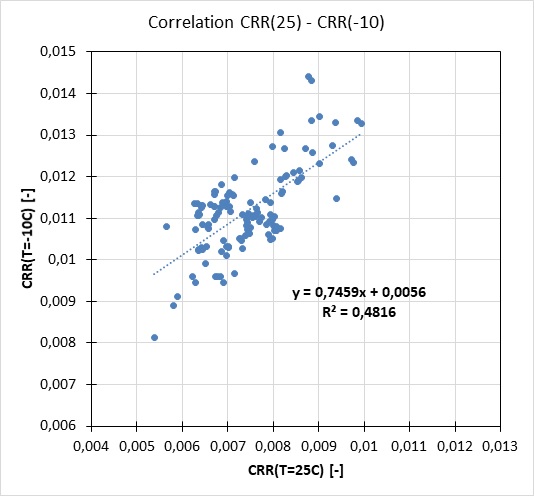WP1
Since the test conditions in accordance with the Regulation R117 are far from the typical road conditions in which the cars are operated, it was necessary to determine the representativeness of the results being the basis for awarding the labels. One possible method of making such an assessment is to compare the CRR values obtained on a smooth steel drum at an ambient temperature of 25 °C with those obtained on the textured road at a more typical temperature of 17 °C. The results indicated that both the absolute values of the CRR and, more importantly, also the mutual relations between the tires are very different when they originate from road tests than measured according to R117. The biggest differences in the ranking of tires are for surfaces with a very aggressive texture (Surface Dressing and Cement Concrete Transversely Grooved).
The fact that the rolling resistance of tires decreases with increasing temperature is a well-known and documented phenomenon. However, the details of how the tire structure and road surface characteristics affect the changes in rolling resistance as a function of ambient temperature are not known. From the ELANORE project point of view, it was very important to state whether or not the tire ranking obtained on a smooth steel drum at 25 ° C is the same as the tire ranking obtained at lower temperatures on typical road surfaces. If the ranking is very similar, it can be assumed that the labeling conducted according to R117 is representative. However, if tires tested in low temperatures (especially winter and All Season tires) have a significantly changed ranking in terms of rolling resistance, this means that the current labeling system leads to wrong decisions regarding the purchase of tires by consumers.
Figure 1 shows the correlation between the results obtained on a steel drum for an ambient temperature of 25 °C and -10 °C. In this case, the Coefficient of Determination (R2) has value of only 0.48, which should be considered as an indicator of large discrepancies in the sensitivity of individual tires to temperature changes. As the ambient temperature required by R117 regulation is 25⁰C, and typical average annual temperature in Europe is only 5 °C the results obtained in 25 ⁰C are very different than obtained in typical conditions due to low R2 value.

Fig. 1. Comparison of CRR values obtained for the same tires measured on a steel drum at 25 °C and -10 °C.
Research conducted under WP1 has proven that the currently used labelling system is not optimal because of very unrepresentative conditions of measurements that are proscribed by Regulation R117. Based on the results obtained, a label system will be proposed under WP3 that allows more objective tire assessment.
 English
English
 Polski
Polski
